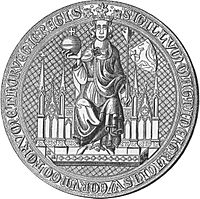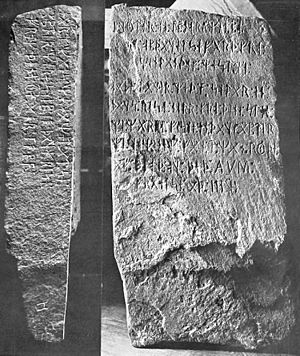Kensington Runestone facts for kids
Quick facts for kids Kensington Runestone |
|
|---|---|

The stone on display in the Alexandria Chamber of Commerce and Runestone Museum
|
|
| Created | 19th century |
| Discovered | 1898 CE Originally Kensington; currently located at Alexandria, Minnesota, United States |
| Discovered by | Olof Öhman |
| Runemaster | Disputed |
| Text – Native | |
| Swedish dialects 8 : göter : ok : 22 : norrmen : po : |
|
| Translation | |
| (word-for-word): Eight Götalanders and 22 Northmen on (this?) exploration journey from Vinland far to the west. We had a camp by two (shelters?) one day's journey north from this stone. We were fishing one day. After we came home, found 10 men red from blood and dead. Ave Maria save from evil. (side of stone) There are 10 men by the inland sea to look after our ships fourteen days journey from this peninsula (or island). Year 1362 |
|
The Kensington Runestone is a large stone slab found in central Minnesota in 1898. It is covered in special carvings called runes. These runes are an old alphabet used by people in Northern Europe.
A Swedish immigrant named Olof Öhman said he found the stone. He was clearing land on his farm near Kensington. The stone's carvings claim to be a message left by Scandinavian explorers from the 14th century. It even has a date: the year 1362.
Since it was found, people have argued if the stone is real or a fake. Most experts believe it is a hoax from the 1800s. Some even think Öhman made it himself. But many people still believe the stone is a true record of early explorers.
Contents
Discovery of the Kensington Runestone
Olof Öhman, who had moved from Sweden, said he found the stone in late 1898. He was clearing trees and stumps from his new land. The stone was lying face down near a small hill. It was tangled in the roots of a young poplar tree.
The stone is about 30 inches long, 16 inches wide, and 6 inches thick. It weighs about 202 pounds (92 kg). Öhman's 10-year-old son, Edward, first noticed the strange markings. Öhman thought it might be an "Indian almanac."
Early Reactions and Doubts
Around the time the stone was found, there was a lot of interest in Leif Erikson and the Vikings. People were talking about their journeys to Vinland (North America). This interest was strong in Scandinavia.
A copy of the stone's carvings was sent to the University of Minnesota. Professor Olaus J. Breda, who studied Scandinavian languages, said the stone was a fake. He wrote an article about it in 1910. Other experts in Scandinavia also agreed it was a fraud.
The stone was then sent to another university. Most experts thought it was a joke or couldn't find a real historical reason for it. So, the stone was returned to Öhman.
Later Investigations and Questions
A Norwegian-American historian named Hjalmar Holand helped bring attention back to the stone. He claimed Öhman gave him the stone. However, records show Öhman sold it for $10 in 1911 to the Minnesota Historical Society.
Geologist Newton Horace Winchell and linguist George T. Flom studied the stone. Winchell looked at how worn the stone was. He thought the carvings looked too fresh to be 500 years old. Another geologist, Harold Edwards, also noted that the letters were "smooth showing virtually no weathering."
Flom, the linguist, found that the runes on the stone were different from those used in the 14th century. Also, the language on the stone was very similar to modern Swedish. It was not like the older Nordic languages from the 1300s. This is a main reason why many experts believe the stone is a hoax.
Today, the Kensington Runestone is on display at the Runestone Museum in Alexandria, Minnesota.
Message on the Stone
The stone has nine lines of text on its front and three lines on its side.
The Runes and Their Meaning
Here is what the stone says in its original form: Front:
- 8 : göter : ok : 22 : norrmen : po :
- ...o : opdagelsefärd : fro :
- vinland : of : vest : vi :
- hade : läger : ved : 2 : skjär : en :
- dags : rise : norr : fro : deno : sten :
- vi : var : ok : fiske : en : dagh : äptir :
- vi : kom : hem : fan : 10 : man : röde :
- af : blod : og : ded : AVM :
- frälse : äf : illü.
Side:
- här : (10) : mans : ve : havet : at : se :
- äptir : vore : skip : 14 : dagh : rise :
- from : deno : öh : ahr : 1362 :
And here is the English translation:
"Eight Geats (people from Götaland, Sweden) and twenty-two Norwegians on an exploration journey from Vinland to the west. We had camp by two skerries (small rocky islands) one day's journey north from this stone. We were [out] to fish one day. After we came home [we] found ten men red of blood and dead. AVM (Ave Virgo Maria, meaning 'Hail Virgin Mary') save [us] from evil."
"[We] have ten men by the sea to look after our ships, fourteen days' travel from this island. [In the] year 1362."
The language used in the inscription is very similar to modern Swedish. This is a big reason why many scholars think it is a fake. If it were truly from 1362, the language would look much older and different.
Possible Historical Connections

We know that Norse people had colonies in Greenland from the late 900s to at least the 1300s. They also built a short-lived settlement in Newfoundland, Canada, called L'Anse aux Meadows, around the 1000s. But there is no other widely accepted proof of Norse people in the Americas before Christopher Columbus.
However, some old documents hint at possible Scandinavian trips to North America in the 1300s. For example, a letter from 1577 mentions eight men who returned to Norway in 1364. They were from an expedition to Arctic islands. One of these men, a priest, shared much geographical information with the King of Norway.
The Paul Knutsson Expedition
In 1354, King Magnus Eriksson of Sweden and Norway sent a letter. It appointed a law officer named Paul Knutsson to lead a trip to the Greenland colony. The goal was to check on reports that the people there were leaving their Christian faith.
Some people who believe the Kensington Runestone is real think Knutsson might have traveled beyond Greenland. They suggest he went to North America looking for these "lost" Greenlanders. They believe most of his group might have been killed in Minnesota, leaving only eight to return to Norway.
However, there is no clear proof that Knutsson's expedition ever sailed. Also, the information about the eight men returning in 1364 suggests they were descendants of earlier colonists, not survivors of a recent trip. These old books and stories were available in the late 1800s. This means someone could have used them to create a hoax.
Possible Travel Routes
If Norse explorers did reach Kensington, they might have traveled through the Hudson Bay. From there, they could have gone up the Nelson River or Hayes River, through Lake Winnipeg, and then up the Red River of the North. This route would connect to the Minnesota River, which flows into the Mississippi River.
This route was known to explorers and traders. They used it to travel from Hudson Bay to Minnesota many years before the area was officially settled.



